Estimating the Growing Stem Volume of the Planted Forest Using the General Linear Model and Time Series Quad-Polarimetric SAR Images
Abstract
:1. Introduction
2. Study Area and Data
2.1. Study Area
2.2. Ground Data
2.3. Polarimetric SAR Images and the Digital Elevation Model (DEM)
3. Method
3.1. Pre-Processing of the Polarimetric SAR Images
3.2. Extraction of Time Series Polarimatric Characteristics
3.2.1. Yamaguchi Decomposition and Polarimatric Characteristics
3.2.2. Time Series Polarimetric Characteristics
3.3. The General Linear Model for GSV Estimation
3.4. Model Assessment
4. Results
4.1. The Extracted Polarimetric Characteristics
4.2. Accuracy of GSV Estimation Using Single SAR Images
4.3. Accuracy of GSV Estimation Using Time Series SAR Images
5. Discussion
5.1. The Sensitivity of Polarimetric Characteristics
5.2. The Estimation Accuracy of GLM
5.3. Single and Time Series SAR Images
6. Conclusions
Author Contributions
Funding
Conflicts of Interest
References
- Keenan, R.J.; Reams, G.A.; Achard, F.; De Freitas, J.V.; Grainger, A.; Lindquist, E. Dynamics of global forest area: Results from the FAO Global Forest Resources Assessment 2015. For. Ecol. Manag. 2015, 352, 9–20. [Google Scholar] [CrossRef]
- Editorial Office. The Eighth National Forest Resources Inventory Indicates Area of Plantation Forest in China Continues to Rank First in the World. China Popul. Today 2014, 2, 40. [Google Scholar]
- Köhl, M.; Lasco, R.; Cifuentes, M.; Jonsson, Ö.; Korhonen, K.T.; Mundhenk, P.; Navar, J.D.J.; Stinson, G. Changes in forest production, biomass and carbon: Results from the 2015 UN FAO Global Forest Resource Assessment. For. Ecol. Manag. 2015, 352, 21–34. [Google Scholar] [CrossRef] [Green Version]
- Sheng, W.T. On the Maintenance of Long-term Productivity of Plantation in China. For. Res. 2018, 31, 1–14. [Google Scholar]
- Kimura, H.; Mizuno, T.; Papathanassiou, K.P.; Hajnsek, I. Improvement of Polarimetric SAR Calibration Based on the Quegan Algorithm. In Proceedings of the IEEE International Geoscience & Remote Sensing Symposium, Anchorage, AK, USA, 20–24 September 2004. [Google Scholar]
- Wijaya, A.; Kusnadi, S.; Gloaguen, R.; Heilmeier, H. Improved strategy for estimating stem volume and forest biomass using moderate resolution remote sensing data and GIS. J. For. Res. 2010, 21, 1–12. [Google Scholar] [CrossRef]
- Chowdhury, T.A.; Thiel, C.; Schmullius, C. Growing stock volume estimation from L-band ALOS PALSAR polarimetric coherence in Siberian forest. Remote Sens. Environ. 2014, 155, 129–144. [Google Scholar] [CrossRef]
- Abdullahi, S.; Kugler, F.; Pretzsch, H. Prediction of stem volume in complex temperate forest stands using TanDEM-X SAR data. Remote Sens. Environ. 2016, 174, 197–211. [Google Scholar] [CrossRef]
- Chowdhury, T.A.; Thiel, C.; Schmullius, C.; Stelmaszczukgórska, M. Polarimetric Parameters for Growing Stock Volume Estimation Using ALOS PALSAR L-Band Data over Siberian Forests. Remote Sens. 2013, 5, 5725–5756. [Google Scholar] [CrossRef] [Green Version]
- Martone, M.; Rizzoli, P.; Wecklich, C.; Gonzalez, C.; Moreira, A. The global forest/non-forest map from TanDEM-X interferometric SAR data. Remote Sens. Environ. 2018, 205, 352–373. [Google Scholar] [CrossRef]
- Joshi, N.; Mitchard, E.T.A.; Brolly, M.; Schumacher, J.; Fernándezlanda, A.; Johannsen, V.K.; Marchamalo, M.; Fensholt, R. Understanding ‘saturation’ of radar signals over forests. Sci. Rep. 2017, 7, 3505. [Google Scholar] [CrossRef] [Green Version]
- Kobayashi, S.; Omura, Y.; Sangangoie, K.; Widyorini, R.; Kawai, S.; Supriadi, B.; Yamaguchi, Y. Characteristics of Decomposition Powers of L-Band Multi-Polarimetric SAR in Assessing Tree Growth of Industrial Plantation Forests in the Tropics. Remote Sens. 2012, 4, 3058–3077. [Google Scholar] [CrossRef] [Green Version]
- Thirion, L.; Colin, E.; Dahon, C. Capabilities of a Forest Coherent Scattering Model Applied to Radiometry, Interferometry, and Polarimetry at P- and L-band. IEEE Trans. Geosci. Remote Sens. 2006, 44, 849–862. [Google Scholar] [CrossRef]
- Ni, W.; Sun, G.; Ranson, K.J.; Zhang, Z.; Guo, Z. Model-Based Analysis of the Influence of Forest Structures on the Scattering Phase Center at L-Band. IEEE Trans. Geosci. Remote Sens. 2014, 52, 3937–3946. [Google Scholar]
- Gonçalves, F.G.; Santos, J.R.; Treuhaft, R.N. Stem volume of tropical forests from polarimetric radar. Int. J. Remote Sens. 2011, 32, 503–522. [Google Scholar] [CrossRef]
- Zhang, H.; Zhu, J.; Wang, C.; Lin, H.; Long, J.; Zhao, L.; Fu, H.; Liu, Z. Forest Growing Stock Volume Estimation in Subtropical Mountain Areas Using PALSAR-2 L-Band PolSAR Data. Forests 2019, 10, 276. [Google Scholar] [CrossRef] [Green Version]
- Antropov, O.; Rauste, Y.; Häme, T.; Praks, J. Polarimetric ALOS PALSAR Time Series in Mapping Biomass of Boreal Forests. Remote Sens. 2017, 9, 999. [Google Scholar] [CrossRef] [Green Version]
- Pulliainen, J.T.; Heiska, K.; Hyyppa, J.; Hallikainen, M.T. Backscattering Properties of Boreal Forests at the C- and X-Bands. IEEE Trans. Geosci. Remote Sens. 1994, 32, 1041–1050. [Google Scholar] [CrossRef]
- Antropov, O.; Rauste, Y.; Ahola, H.; Hame, T. Stand-Level Stem Volume of Boreal Forests from Spaceborne SAR Imagery at L-Band. IEEE J. Sel. Top. Appl. Earth Obs. Remote Sens. 2013, 6, 35–44. [Google Scholar] [CrossRef]
- Pulliainen, J.T.; Kurvonen, L.; Hallikainen, M.T. Multitemporal ehavior of L- and C-band SAR observations of boreal forests. IEEE Trans. Geosci. Remote Sens. 1999, 37, 927–937. [Google Scholar] [CrossRef]
- Wagner, W.; Vietmeier, J.; Schmullius, C.; Davidson, M.; Toan, T.L.; Quegan, S.; Yu, J.J.; Luckman, A.; Tansey, K.; Balzter, H. The Use of Coherence Information from ERS Tandem Pairs for Determining Forest Stock Volume in SIBERIA. In Proceedings of the IEEE International Geoscience & Remote Sensing Symposium, Honolulu, HI, USA, USA, 24–28 July 2000. [Google Scholar]
- Santoro, M.; Askne, J.; Smith, G.; Fransson, J.E.S. Stem volume retrieval in boreal forests from ERS-1/2 interferometry. Remote Sens. Environ. 2002, 81, 19–35. [Google Scholar] [CrossRef]
- Thiel, C.; Schmullius, C. The potential of ALOS PALSAR backscatter and InSAR coherence for forest growing stock volume estimation in Central Siberia. Remote Sens. Environ. 2016, 173, 258–273. [Google Scholar] [CrossRef]
- Thiel, C.; Schmullius, C. Investigating ALOS PALSAR interferometric coherence in central Siberia at unfrozen and frozen conditions: Implications for forest growing stock volume estimation. Can. J. Remote Sens. 2013, 39, 232–250. [Google Scholar] [CrossRef]
- Kobayashi, S.; Omura, Y.; Sanga-Ngoie, K.; Yamaguchi, Y.; Widyorini, R.; Fujita, M.S.; Supriadi, B.; Kawai, S. Yearly Variation of Acacia Plantation Forests Obtained by Polarimetric Analysis of ALOS PALSAR Data. IEEE J. Sel. Top. Appl. Earth Obs. Remote Sens. 2016, 8, 5294–5304. [Google Scholar] [CrossRef]
- Santoro, M.; Beer, C.; Cartus, O.; Schmullius, C.; Shvidenko, A.; Mccallum, I.; Wegmüller, U.; Wiesmann, A. Retrieval of growing stock volume in boreal forest using hyper-temporal series of Envisat ASAR ScanSAR backscatter measurements. Remote Sens. Environ. 2011, 115, 490–507. [Google Scholar] [CrossRef]
- Cartus, O.; Santoro, M.; Kellndorfer, J. Mapping forest aboveground biomass in the Northeastern United States with ALOS PALSAR dual-polarization L-band. Remote Sens. Environ. 2012, 124, 466–478. [Google Scholar] [CrossRef]
- Lee, J.S.; Pottier, E. Polarimetric Radar Imaging: Basics to Applications, 2nd ed.; CRC Press: Boca Raton, FL, USA, 2016. [Google Scholar]
- Cloude, S.R.; Zebker, H. Polarisation: Applications in Remote Sensing. Phys. Today 2010, 63, 53–54. [Google Scholar]
- Fu, H.; Zhu, J.; Wang, C.; Wang, H.; Rong, Z. Underlying Topography Estimation over Forest Areas Using High-Resolution P-Band Single-Baseline PolInSAR Data. Remote Sens. 2017, 9, 363. [Google Scholar] [CrossRef] [Green Version]
- Kobayashi, A.S.; Sanga-Ngoie, K.; Widyorini, R.; Kawai, S.; Omura, Y.; Supriadi, B. Backscattering characteristics of L-band polarimetric and optical satellite imagery over planted acacia forests in Sumatra, Indonesia. J. Appl. Remote Sens. 2012, 6, 63525. [Google Scholar]
- Woodhouse, I.H.; Mitchard, E.T.A.; Brolly, M.; Maniatis, D.; Ryan, C.M. Radar backscatter is not a ‘direct measure’ of forest biomass. Nat. Clim. Chang. 2012, 2, 556–557. [Google Scholar] [CrossRef]
- Wagner, W.; Luckman, A.; Vietmeier, J.; Tansey, K.; Balzter, H.; Schmullius, C.; Davidson, M.; Gaveau, D.; Gluck, M.; Toan, T.L. Large-scale mapping of boreal forest in SIBERIA using ERS tandem coherence and JERS backscatter data. Remote Sens. Environ. 2003, 85, 125–144. [Google Scholar] [CrossRef]
- Chowdhury, T.A.; Thiel, C.; Schmullius, C. Assessment of Potentiality of L-Band Quadpol Radar for the Retrieval of Growing Stock Volume and Forest Structural Parameters in Central Siberia. ESASP 2010, 686, 35. [Google Scholar]
- Santoro, M.; Eriksson, L.; Askne, J.; Schmullius, C. Assessment of stand-wise stem volume retrieval in boreal forest from JERS-1 L-band SAR backscatter. Int. J. Remote Sens. 2006, 27, 3425–3454. [Google Scholar] [CrossRef]
- Santoro, M.; Cartus, O.; Fransson, J.E.S.; Shvidenko, A.; Mccallum, I.; Hall, R.J.; Beaudoin, A.; Beer, C.; Schmullius, C. Estimates of Forest Growing Stock Volume for Sweden, Central Siberia, and Québec Using Envisat Advanced Synthetic Aperture Radar Backscatter Data. Remote Sens. 2013, 5, 4503–4532. [Google Scholar] [CrossRef] [Green Version]
- Santoro, M.; Shvidenko, A.; Mccallum, I.; Askne, J.; Schmullius, C. Properties of ERS-1/2 coherence in the Siberian boreal forest and implications for stem volume retrieval. Remote Sens. Environ. 2007, 106, 154–172. [Google Scholar] [CrossRef]
- Freeman, A. Calibration of linearly polarized polarimetric SAR data subject to Faraday rotation. IEEE Trans. Geosci. Remote Sens. 2004, 42, 1617–1624. [Google Scholar] [CrossRef]
- Hongquan, W.; Ramata, M.; Kalifa, G.T. Potential of a two-component polarimetric decomposition at C-band for soil moisture retrieval over agricultural fields. Remote Sens. Environ. 2018, 217, 38–51. [Google Scholar]
- Xiang, D.; Ban, Y.; Su, Y. Model-Based Decomposition with Cross Scattering for Polarimetric SAR Urban Areas. IEEE Geosci. Remote Sens. Lett. 2015, 12, 2496–2500. [Google Scholar] [CrossRef]
- Cui, Y.; Yamaguchi, Y.; Yang, J.; Park, S.E.; Kobayashi, H.; Singh, G. Three-Component Power Decomposition for Polarimetric SAR Data Based on Adaptive Volume Scatter Modeling. Remote Sens. 2012, 4, 1559–1572. [Google Scholar] [CrossRef] [Green Version]
- Bhattacharya, A.; Muhuri, A.; De, S.; Manickam, S.; Frery, A.C. Modifying the Yamaguchi Four-Component Decomposition Scattering Powers Using a Stochastic Distance. Mathematics 2015, 8, 3497–3506. [Google Scholar] [CrossRef] [Green Version]
- Jagdhuber, T.; Hajnsek, I.; Papathanassiou, K.P. An Iterative Generalized Hybrid Decomposition for Soil Moisture Retrieval Under Vegetation Cover Using Fully Polarimetric SAR. IEEE J. Sel. Top. Appl. Earth Obs. Remote Sens. 2015, 8, 3911–3922. [Google Scholar] [CrossRef]
- Eriksson, L.E.B.; Santoro, M.; Wiesmann, A.; Schmullius, C.C. Multitemporal JERS repeat-pass coherence for growing-stock volume estimation of Siberian forest. IEEE Trans. Geosci. Remote Sens. 2003, 41, 1561–1570. [Google Scholar] [CrossRef]
- Mohanty, S.; Singh, G.; Yamaguchi, Y. Faraday Rotation Correction and Total Electron Content Estimation Using ALOS-2/PALSAR-2 full Polarimetric SAR Data. In Proceedings of the 2016 IEEE International Geoscience and Remote Sensing Symposium (IGARSS), Beijing, China, 10–15 July 2016. [Google Scholar]
- Rauste, Y. Multi-temporal JERS SAR data in boreal forest biomass mapping. Remote Sens. Environ. 2005, 97, 263–275. [Google Scholar] [CrossRef]
- Santoro, M.; Askne, J.I.H.; Beer, C.; Cartus, O.; Schmullius, C.; Wegmüller, U.; Wiesmann, A. Automatic Model Inversion of Multi-Temporal C-band Coherence and Backscatter Measurements for Forest Stem Volume Retrieval. In Proceedings of the 2008 IEEE International Geoscience and Remote Sensing Symposium, Boston, MA, USA, 7–11 July 2008. [Google Scholar]
- Shao, Y.; Zhang, F.; Xu, M.; Xia, Z.; Touzi, R. Forest Mapping Using Multi-Temporal Polarimetric SAR Data in Southwest China. In Proceedings of the 2011 IEEE International Geoscience and Remote Sensing Symposium, Vancouver, BC, Canada, 24–29 July 2011. [Google Scholar]
- Zhang, X.; Zhang, J.; Duan, A. Compatibility of Stand Volume Model for Chinese Fir Based on Tree-Level and Stand-Level. Sci. Silvae Sin. 2014, 50, 82–87. [Google Scholar]
- Zheng, D.; Guodeng, H.U.; Chen, P.; Gong, Z. The Selection and Error Analysis of the Angle Gauge Constant in the Chinese-fir Plantation at Different Ages. For. Resour. Manag. 2006, 2, 74–78. [Google Scholar]
- Chen, J.; Quegan, S. Calibration of Spaceborne CTLR Compact Polarimetric Low-Frequency SAR Using Mixed Radar Calibrators. IEEE Trans. Geosci. Remote Sens. 2011, 49, 2712–2723. [Google Scholar] [CrossRef]
- Lee, J.S.; Schuler, D.L.; Ainsworth, T.L. Polarimetric SAR data compensation for terrain azimuth slope variation. IEEE Trans. Geosci. Remote Sens. 2000, 38, 2153–2163. [Google Scholar]
- Schuler, D.L.; Lee, J.S.; Grandi, G.D. Measurement of topography using polarimetric SAR images. IEEE Trans. Geosci. Remote Sens. 1996, 34, 1266–1277. [Google Scholar] [CrossRef]
- Lee, J.S.; Schuler, D.L.; Ainsworth, T.L.; Krogager, E.; Kasilingam, D.; Boerner, W.M. On the estimation of radar polarization orientation shifts induced by terrain slopes. IEEE Trans. Geosci. Remote Sens. 2002, 40, 30–41. [Google Scholar]
- Ratha, D.; Surendar, M.; Bhattacharya, A. Improvement of PolSAR decomposition scattering powers using a relative decorrelation measure. Remote Sens. Lett. 2017, 8, 340–349. [Google Scholar] [CrossRef]

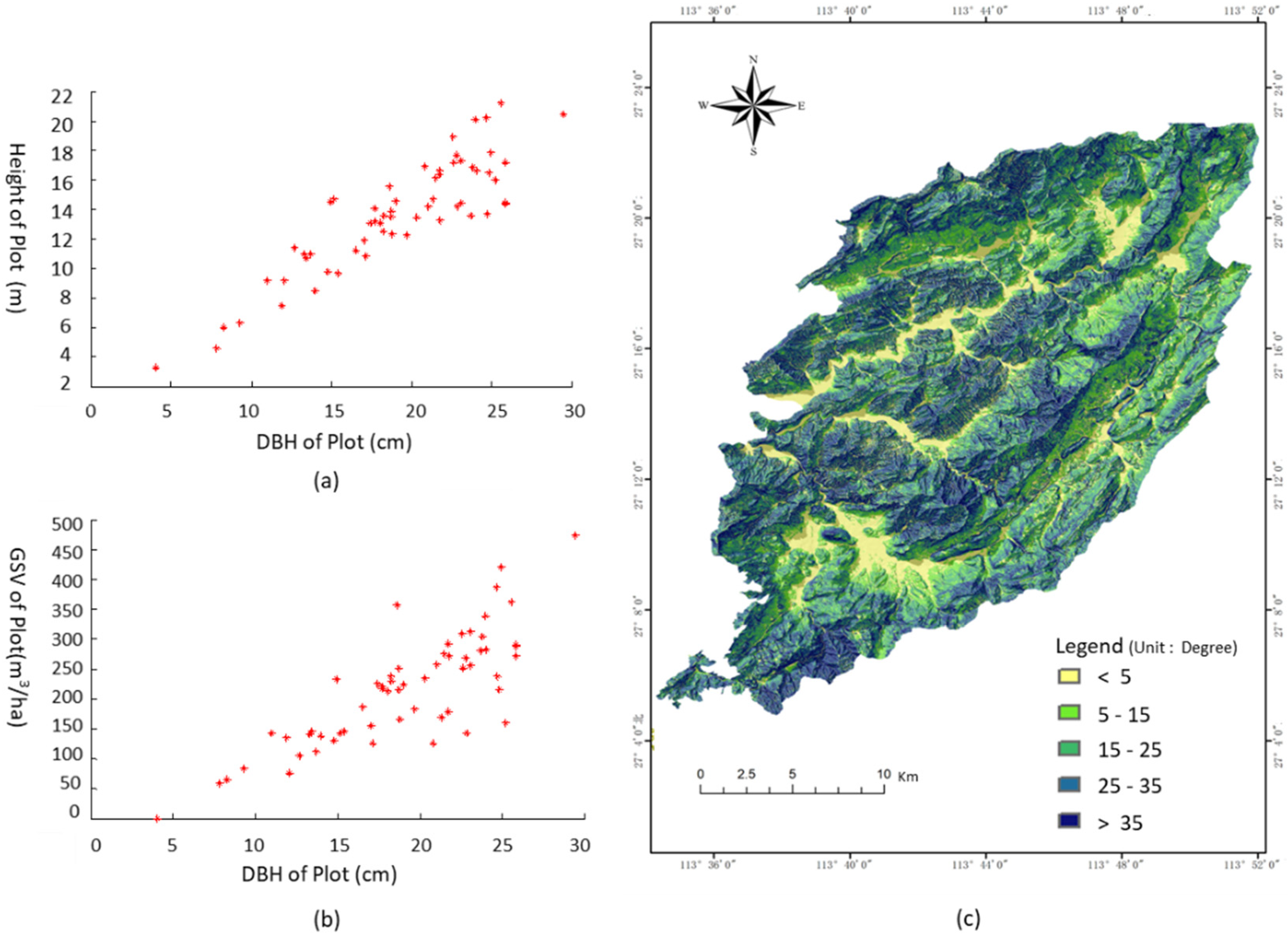
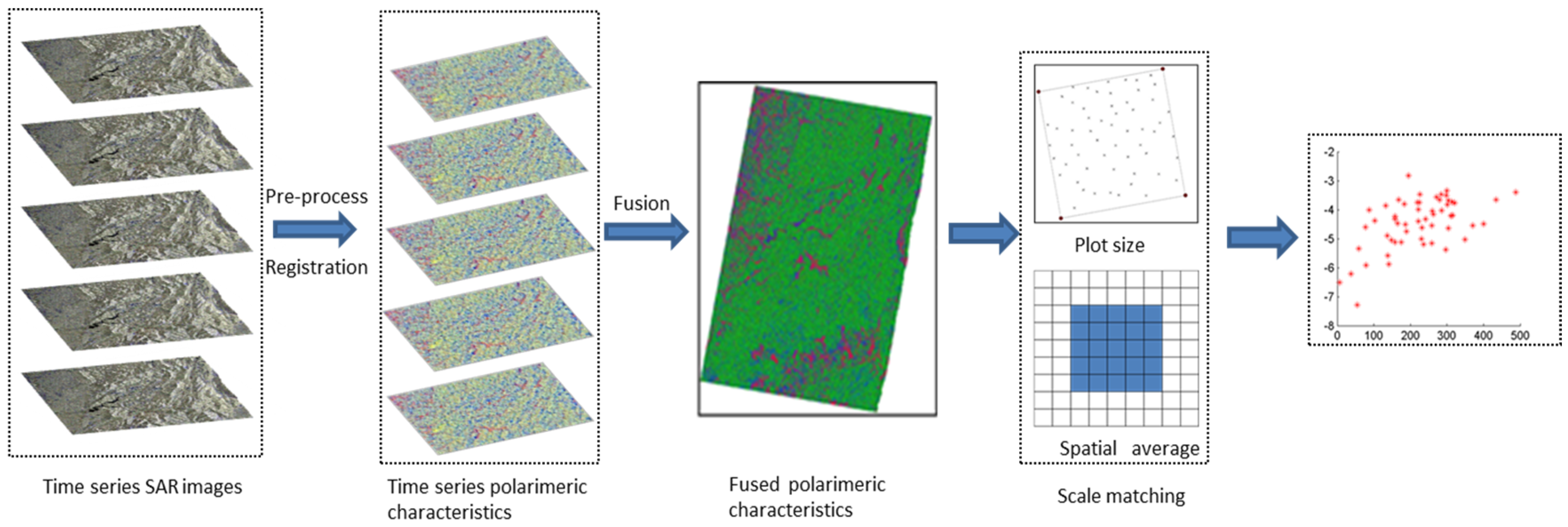
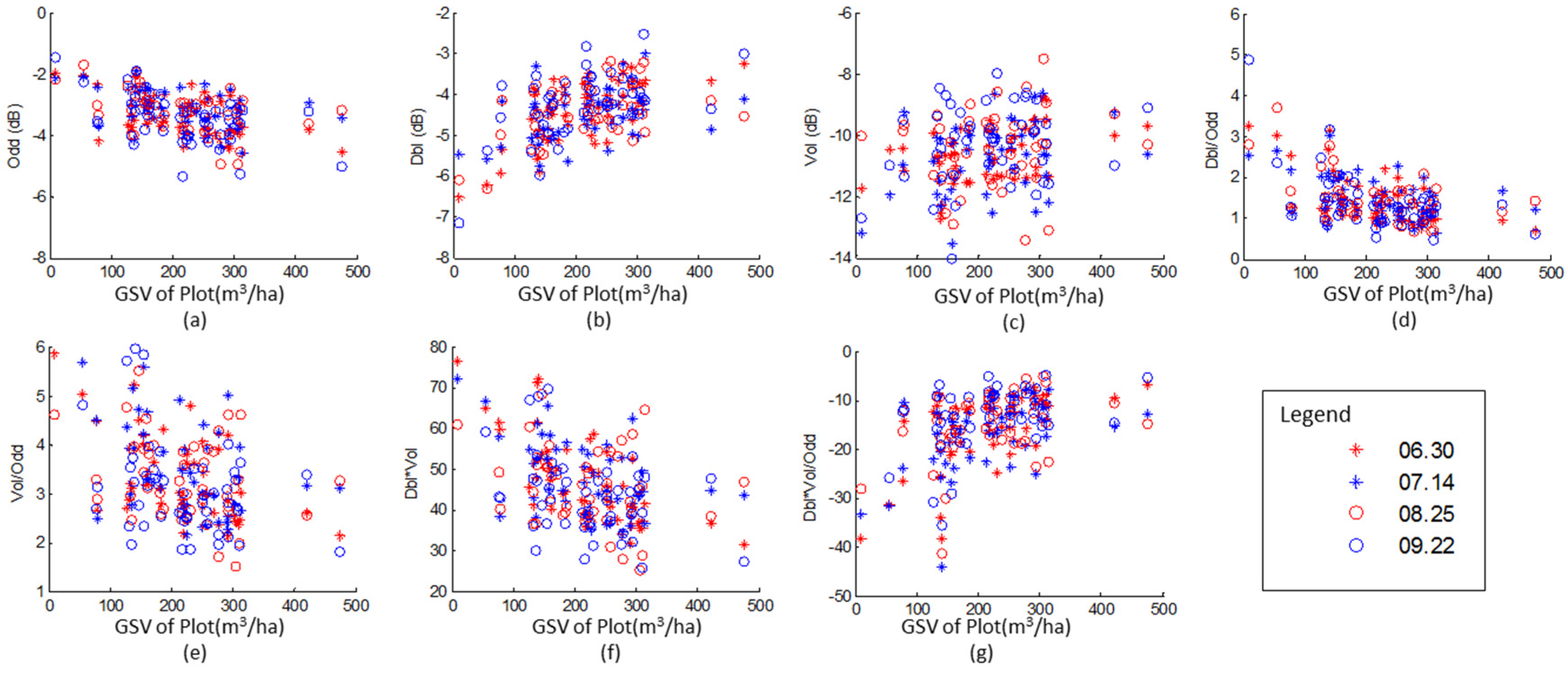
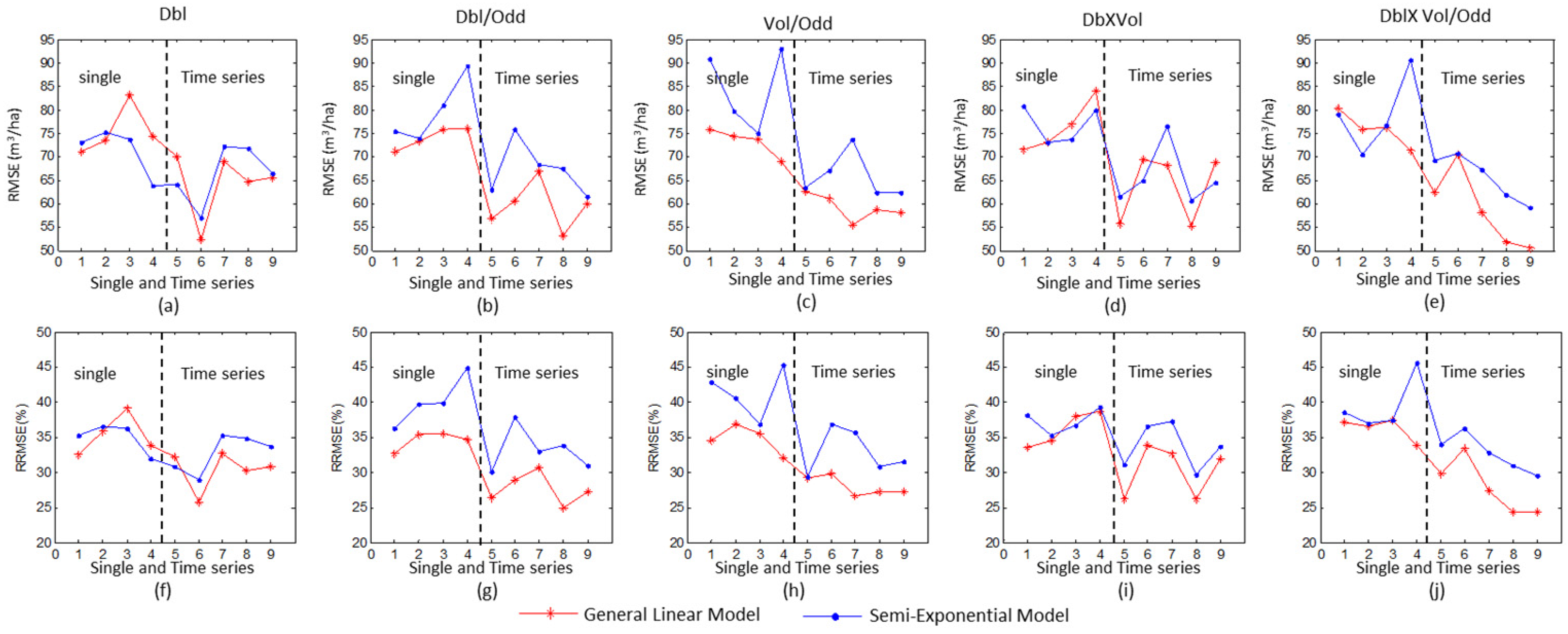
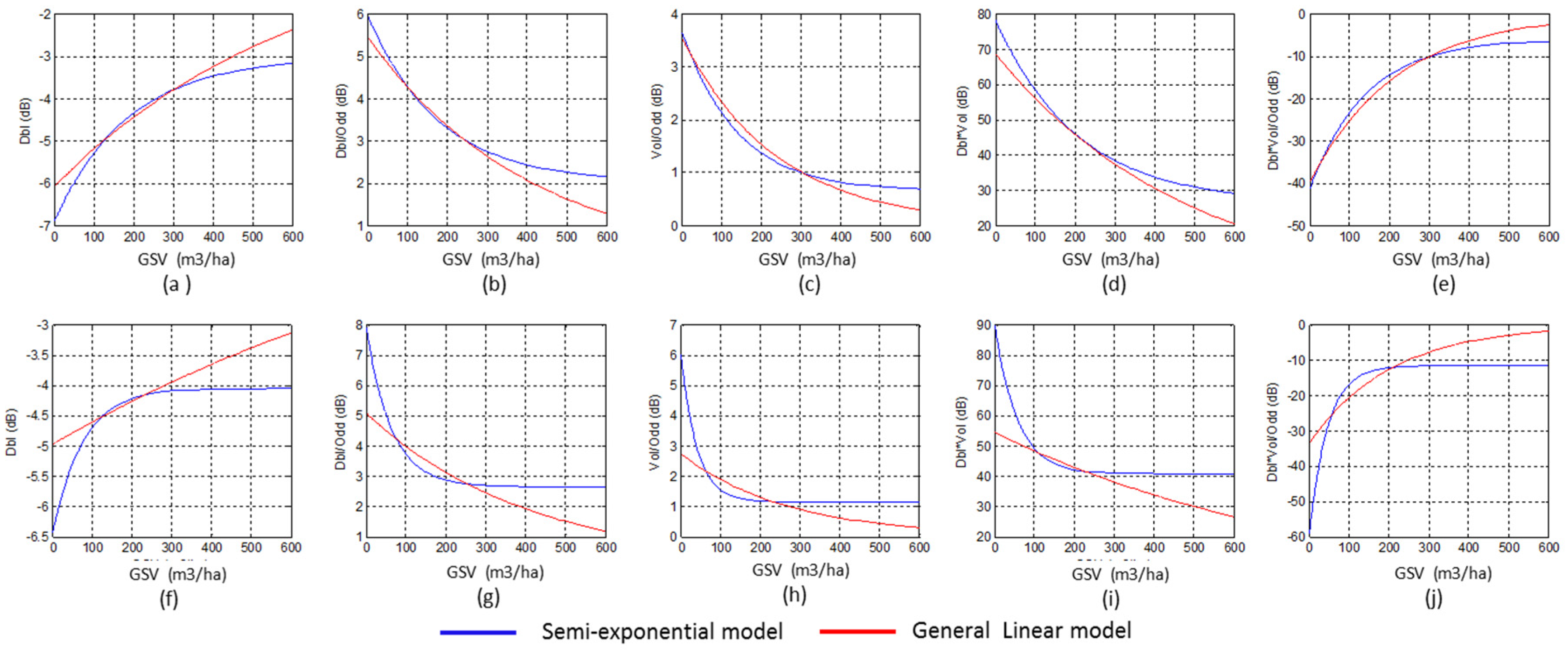


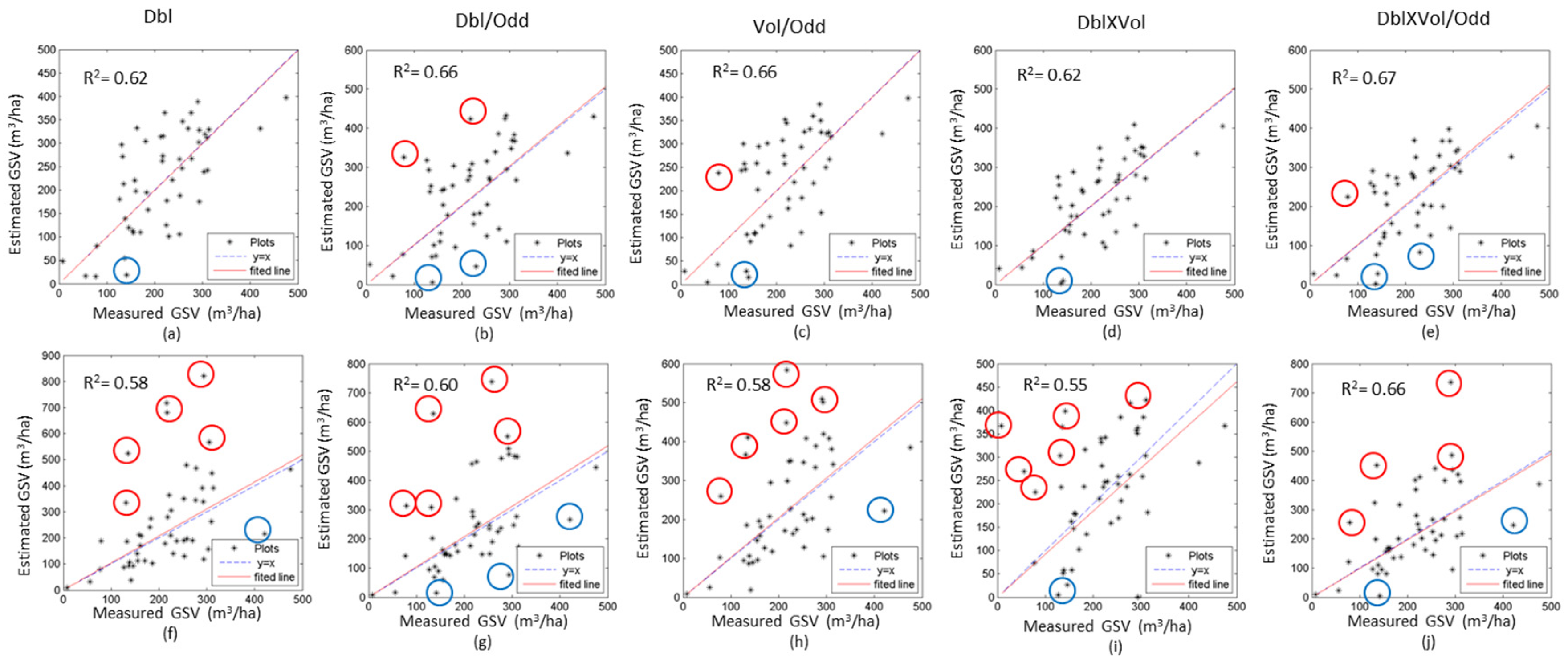

| Sensor | Acquired Date | Central Latitude (Degree) | Central Longitude (Degree) | Band | Polarimetry |
|---|---|---|---|---|---|
| PALSAR-2 | 2016.06.30 | 27.179 | 113.676 | L | HH + HV + VH + VV |
| PALSAR-2 | 2016.07.14 | 27.179 | 113.677 | L | HH + HV + VH + VV |
| PALSAR-2 | 2016.08.25 | 27.179 | 113.678 | L | HH + HV + VH + VV |
| PALSAR-2 | 2016.09.22 | 27.175 | 113.678 | L | HH + HV + VH + VV |
| Acquired Date | Temperature (°C) | Wind Direction | Beaufort Scale (Grade) | Weather at Acquired Time | 3 Days Before Acquired |
|---|---|---|---|---|---|
| 2016.06.30 | 26–35 | South | less than 3 | cloudy | sunny |
| 2016.07.14 | 27–35 | South | less than 3 | Showers | Showers |
| 2016.08.25 | 25–37 | North | 3–4 | Showers | Showers |
| 2016.09.22 | 19–30 | North | 3–4 | clear | sunny |
| Odd | Dbl | Vol | Dbl/Odd | Vol/Odd | Dbl×Vol | Dbl×Vol/Odd | Notes | |
|---|---|---|---|---|---|---|---|---|
| 06.30 (1) | −0.557 | 0.702 | 0.437 | −0.569 | −0.626 | −0.709 | 0.624 | Single |
| 07.14 (2) | −0.421 | 0.392 | 0.360 | −0.473 | −0.462 | −0.479 | 0.484 | Single |
| 08.25 (3) | −0.415 | 0.421 | 0.210 * | −0.385 | −0.461 | −0.367 | 0.415 | Single |
| 09.22 (4) | −0.484 | 0.529 | 0.207 * | −0.476 | −0.526 | −0.483 | 0.503 | Single |
| 1, 4 | −0.612 | 0.696 | 0.416 | −0.588 | −0.625 | −0.673 | 0.612 | Time series |
| 2, 3 | −0.465 | 0.466 | 0.326 * | −0.467 | −0.505 | −0.466 | 0.487 | Time series |
| 1, 2, 3 | −0.566 | 0.623 | 0.421 | −0.550 | −0.596 | −0.609 | 0.578 | Time series |
| 2, 3, 4 | −0.613 | 0.659 | 0.478 | −0.590 | −0.620 | −0.655 | 0.607 | Time series |
| 1, 2, 3, 4 | −0.594 | 0.634 | 0.436 | −0.568 | −0.608 | −0.617 | 0.590 | Time series |
| Method | Acquired Date | Dbl | Dbl/Odd | Vol/Odd | Dbl×Vol | Dbl×Vol/Odd |
|---|---|---|---|---|---|---|
| General linear model | 06.30 | 0.60 | 0.61 | 0.56 | 0.60 | 0.55 |
| 07.14 | 0.58 | 0.51 | 0.51 | 0.56 | 0.51 | |
| 08.25 | 0.43 | 0.54 | 0.53 | 0.59 | 0.50 | |
| 09.22 | 0.52 | 0.53 | 0.58 | 0.55 | 0.57 | |
| Semi-exponential model | 06.30 | 0.56 | 0.55 | 0.51 | 0.56 | 0.55 |
| 07.14 | 0.58 | 0.50 | 0.53 | 0.54 | 0.52 | |
| 08.25 | 0.46 | 0.50 | 0.53 | 0.56 | 0.55 | |
| 09.22 | 0.54 | 0.36 | 0.33 | 0.41 | 0.32 |
| Semi-Exponential Model | General Linear Model | ||||||
|---|---|---|---|---|---|---|---|
| RMSE (m3/ha) | RRMSE (%) | R2 | RMSE (m3/ha) | RRMSE (%) | R2 | ||
| Dbl×Vol/Odd from single image | 06.30 (1) | 79.12 | 38.64 | 0.59 | 80.34 | 40.09 | 0.47 |
| 07.14 (2) | 70.50 * | 36.97 * | 0.65 * | 75.92 | 36.60 | 0.46 | |
| 08.25 (3) | 76.68 * | 37.50 * | 0.42 * | 76.24 | 37.39 | 0.36 | |
| 09.22 (4) | 90.68 | 45.67 | 0.21 | 71.23 | 33.87 | 0.47 | |
| Dbl×Vol/Odd from time series images | 1, 4 | 69.27 | 34.05 | 0.50 | 62.23 | 29.80 | 0.53 |
| 2, 3 | 70.76 * | 36.29 * | 0.42 * | 70.49 | 33.46 | 0.45 | |
| 1, 2, 3 | 67.33 | 32.88 | 0.52 | 58.08 | 27.37 | 0.55 | |
| 2, 3, 4 | 61.80 | 31.04 | 0.58 | 52.88 | 25.32 | 0.63 | |
| 1, 2, 3, 4 | 59.21 * | 29.60 * | 0.55 * | 50.64 | 24.42 | 0.60 | |
| Method | Combination | Dbl | Dbl/Odd | Vol/Odd | Dbl×Vol | Dbl×Vol/Odd |
|---|---|---|---|---|---|---|
| General linear model | 1, 4 | 0.61 | 0.62 | 0.62 | 0.69 | 0.63 |
| 2, 3 | 0.67 | 0.62 | 0.59 | 0.59 | 0.57 | |
| 1, 2, 3 | 0.59 | 0.64 | 0.63 | 0.59 | 0.65 | |
| 2, 3, 4 | 0.62 | 0.66 | 0.65 | 0.69 | 0.71 | |
| 1, 2, 3, 4 | 0.62 | 0.66 | 0.66 | 0.62 | 0.67 | |
| Semi-exponential model | 1, 4 | 0.63 | 0.63 | 0.65 | 0.54 | 0.55 |
| 2, 3 | 0.64 | 0.35 | 0.49 | 0.53 | 0.55 | |
| 1, 2, 3 | 0.59 | 0.61 | 0.56 | 0.58 | 0.63 | |
| 2, 3, 4 | 0.59 | 0.60 | 0.64 | 0.60 | 0.63 | |
| 1, 2, 3, 4 | 0.58 | 0.60 | 0.58 | 0.55 | 0.66 |
© 2020 by the authors. Licensee MDPI, Basel, Switzerland. This article is an open access article distributed under the terms and conditions of the Creative Commons Attribution (CC BY) license (http://creativecommons.org/licenses/by/4.0/).
Share and Cite
Long, J.; Lin, H.; Wang, G.; Sun, H.; Yan, E. Estimating the Growing Stem Volume of the Planted Forest Using the General Linear Model and Time Series Quad-Polarimetric SAR Images. Sensors 2020, 20, 3957. https://doi.org/10.3390/s20143957
Long J, Lin H, Wang G, Sun H, Yan E. Estimating the Growing Stem Volume of the Planted Forest Using the General Linear Model and Time Series Quad-Polarimetric SAR Images. Sensors. 2020; 20(14):3957. https://doi.org/10.3390/s20143957
Chicago/Turabian StyleLong, Jiangping, Hui Lin, Guangxing Wang, Hua Sun, and Enping Yan. 2020. "Estimating the Growing Stem Volume of the Planted Forest Using the General Linear Model and Time Series Quad-Polarimetric SAR Images" Sensors 20, no. 14: 3957. https://doi.org/10.3390/s20143957





